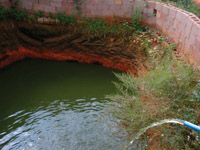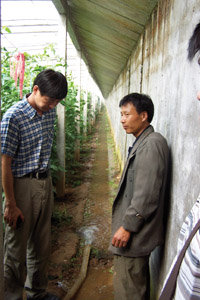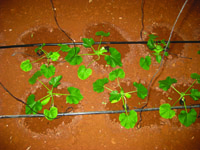
Features
Business
Grower Profiles
Special Series world report #2: Testing the waters
September 28, 2010 By Brad McDonald and Jennifer Wacasey
Once again, please join us as we share our greenhouse observations with you in a series of articles for Greenhouse Canada.
Once again, please join us as we share our greenhouse observations with you in a series of articles for Greenhouse Canada. Both of us have had the wonderful experience of being involved with the Canadian horticultural industry for many years. Now we are working with horticulture on a global scale. In our positions with the International Division of Plant Products Co. Ltd., we travel the world, providing product and technical support for Plant-Prod and Plantex fertilizer sales. This has given us the opportunity to see many different countries, crops, growing techniques and growing conditions.
In this second article, we will be describing some of what we have seen in the areas of water, media and fertilizer. As in our first article, it is just a whirlwind tour, touching briefly on some of the interesting and unusual things that we have encountered.
For those of us familiar with growing greenhouse crops, we know that water quality and quantity are major factors not only in locating a greenhouse, but also in the planning of the fertility program itself. Water quantity and quality are among the first considerations when locating a greenhouse operation. You may recall being taught that if the water source was not of an acceptable quality for growing plants, then definitely consider a different location for your greenhouse.
MANY OPTIONS AVAILABLE FOR TREATING POOR QUALITY WATER
■ Today there are more options for treating poor quality water, but these are expensive and the equipment and technology may be difficult to come by in some countries. In much of Canada, we have the luxury of an abundant supply of good quality water, but in many parts of the world, this is not the case.
The island of Cyprus, off the coast of Turkey, suffered a serious and prolonged drought that peaked in 2008 after several winters of low rainfall. The government increased desalination plants, but it was also necessary to import water by sea tanker from Greece. There was no guarantee that the water would be the best quality for greenhouse crops, and growers were restricted in the amount of water they could use. Growers simply took what they could get. Because of the shortage of water, leaching was not an option and unwanted salts tended to build up in the media.
In the deserts of the Saudi peninsula, wells are drilled hundreds of feet in an effort to access a water source. Unfortunately, the tapped water is often saline. In other countries, growers must draw water from reservoirs or canals where the leachate from neighbouring farms and greenhouses has drained for decades. For us, this can make planning a nutrition program challenging, as the levels of different nutrients in the water fluctuate with rainfall and runoff.
ELABORATE SYSTEMS FOR CAPTURING AND STORING RAINWATER
■ By contrast, there are greenhouses with elaborate systems for capturing and storing rainwater. Of course, “pure water” has its own challenges. Because of the lack of buffering capacity in the water and depending on the fertilizer used, the media pH can drop too low. Since there are no nutrients in the water, everything the plant requires must come from the fertilizer. This type of water also has to be understood and managed. Some progressive fertilizer companies have developed formulations suited to specific types of water. This makes things easier for the grower, but it still means they must have an understanding of their water so that they can choose the correct fertilizer formulation.
 |
|
| It is difficult to avoid algae buildup when you start with water like this. |
We usually say that to grow a good crop, you need to have a recent and complete water test. This gives a clear idea of any challenges that the water presents and a grower can develop a plan for managing those challenges. Sadly, many growers worldwide have little to no knowledge or understanding of the quality of their water. Their crops continue to grow, but how much better could crop quality be and how much higher could yields be if they had a water test, along with basic information on how to grow using different water qualities?
MORE GROWERS INCORPORATING RECIRCULATION TECHNOLOGIES
■ As countries recognize the potentially harmful effect of allowing leached nutrient solution to run into the ground or bodies of water, we will see more and more growers practise recirculation, where water and nutrient solution are captured and reused. We have seen growers use their leachate from hydroponic strawberry production to fertilize tomatoes, beans and cucumbers being grown in the soil in another greenhouse. It’s a good use of the nutrient solution, but when asked what they are actually feeding the second crop, they had no idea. The grower might have an EC meter and a pH meter, but most don’t in many areas.
 |
|
| This is an irrigation system where water flows through canals inside the greenhouse (on the right, running the length of the greenhouse); from this canal the water flows down channels along the plant rows. |
The lack of local labs in some countries means we have to make fertilizer recommendations relying only on what we see and what we are told by the grower. It is difficult to provide a reasonable plant nutrition program with minimal or no information, but that is how things are done in much of the world. In some places, there are labs, but a grower might not get test results for six months, which is hardly useful for correcting crop deficiencies in the greenhouse right now. Often, lab testing is viewed as being too expensive or an unnecessary expense. Labs sometimes provide the results in units that we don’t use on a regular basis. It is a good test of our memory and flexibility to give recommendations in whatever way the local growers can understand. Thank goodness for pocket calculators!
A BROAD RANGE OF GROWING MEDIA BEING USED
■ As to growing media, there is an amazing range of materials that provide suitable conditions for the growth of plant roots – hydroponic production of strawberries grown in coir, lettuce grown in Leca, and tomatoes grown in sand and sawdust. In Bulgaria, cucumber seedlings may be planted into straw bales to get the benefit of additional heat generated as the straw bales begin to compost and decompose. In areas of western Europe where a higher level of technology is applied, growers make use of soilless medium, crops are grown in peat, coir or bark-based media. If you travel to other parts of the world, this changes. For much of the world’s greenhouse production, plants are still grown in the soil. The challenge here is the high levels of salt accumulation that growers must deal with and the resulting crop damage. It is true that you can grow plants in almost anything, as long as you learn how to manage water, oxygen and nutrients.
 |
|
| Zucchini being grown with drip irrigation in a greenhouse in Cyprus. |
As for fertilizers, this crop input is as varied as you can imagine. Organic sources are still used throughout much of the world. In some countries, these are composted and processed products and adhere to strict company standards. However, inorganic products are the most common at dealer and grower locations. Seemingly every country in the world tries its hand at manufacturing an NPK blend of fertilizer. Quality varies widely. It is noteworthy that some of the fertilizers manufactured in North America are regarded as the world’s highest quality products.
It is also fascinating to look at the wide variety of fertilizers available and how they are marketed. Some bags have little writing and rely on pictures of crops to steer growers to the correct analysis. This can be important in countries where literacy rates are low. In other areas, growers demand a high level of technical information and support from fertilizer companies. Growers may buy their fertilizer in amounts as small as 25 grams; others buy a container load at one time.
Nutrient application methods also vary widely. Applications could follow a constant, very strict and detailed fertility program, or by contrast, a grower may only apply a small amount of fertilizer when he can afford it. If a grower is very poor, he is probably using natural fertilizer materials such as manure, night soil or plant waste. Foliar feeding may be used when micronutrient deficiencies are observed.
From flood irrigation to gravity fed drip systems to high tech injection systems, the world of crop fertilization is a museum of technology. Interestingly, regardless of the level of technology, growers still produce crops that sustain the farm – only quality and yield vary.
At times, we deal with people where there is not even a basic knowledge of plant physiology and biology. Sometimes the information they have is outdated or more like folk wisdom. Trying to explain why they would benefit from doing certain things is extremely challenging. On other occasions, we talk to highly educated growers who teach us a thing or two.
Regardless of the level of sophistication and technology, the basic purpose of the greenhouse remains the same … to provide protection to crops so that quality and yields can be maximized. We are constantly amazed by the resourcefulness of growers and the ingenuity required to manage their particular operations, and we feel privileged to be a part of it.
 |

|
Brad McDonald is sales manager with Plant Products Ltd., and Jennifer Wacasey is regional manager with the company’s International Division.
Print this page